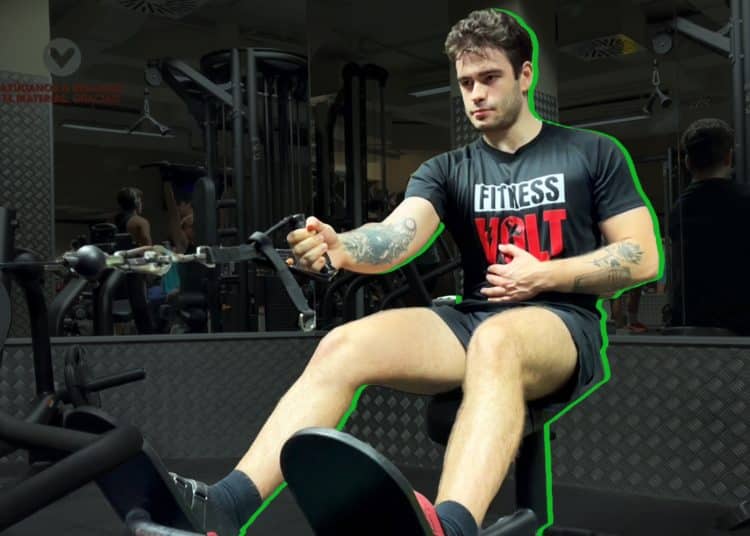Many lifters get to a point where they feel like they’re practically living in the gym and pushing each set to failure but still aren’t making noticeable gains. More often than not, this is a classic case of junk volume.
Fitness Instagram has been echoing the ‘more is better’ mantra for years, which has led countless people to muscle and strength plateaus and even injuries.
In this article, I demystify the concept of junk volume and share knowledge that’ll help you structure your workouts and provide actionable strategies to eliminate it for good. We have a lot to unpack, so sit tight and read on.
Defining “Junk Volume”
More is not always better when it comes to strength training. As someone who spends most of his days in the gym, I’ve seen firsthand how increasing training volume can become counterproductive.
Before we dive deep into the nitty-gritty of junk volume, let’s spend a few minutes understanding the concept.
Level Up Your Fitness: Join our 💪 strong community in Fitness Volt Newsletter. Get daily inspiration, expert-backed workouts, nutrition tips, the latest in strength sports, and the support you need to reach your goals. Subscribe for free!
According to research, performing three to five sets of 12-15 reps of an exercise with moderate loads (60-80 percent of your 1RM) maximizes hypertrophy. (1)
Junk volume refers to any extra sets and reps that you perform over this recommended volume, hoping to supercharge your strength and muscle gains. While this might feel like the right thing to do, you aren’t doing anything more than adding systematic fatigue.
Unlike local fatigue that affects individual muscles, systematic fatigue refers to widespread exhaustion that affects your central nervous system (CNS) due to prolonged, high-intensity physical stress.
Science Behind Effective Muscle Growth
You need mechanical tension (the force your muscles generate when you lift weights), metabolic stress (muscle burning sensation), and muscle damage to maximize hypertrophy, and resistance training is the best way to achieve this. (2)
Progressive overload is key when it comes to building muscle. It involves gradually increasing the load on your muscles to ensure consistent progress. You could achieve this by lifting heavier weights, doing more reps and sets, and employing advanced training techniques.
The real hypertrophy magic happens in the last few reps of a set, as they recruit higher threshold motor units. This means you must push your sets to a point where you couldn’t do another rep without compromising form.
The sad part is that our bodies have a threshold.
Doing more sets and reps of an exercise doesn’t necessarily lead to great muscle fiber stimulation and subsequent adaptations. In fact, experts believe that piling on more volume often leads to diminishing returns.
Then, when it’s time for recovery, your body deploys more resources toward repairing the additional damage from the junk volume, taking away from muscle protein synthesis.
This can lead to prolonged soreness, increased fatigue, and hinder your ability to perform optimally in subsequent workouts.
Key Indicators You Might Be Doing Too Much “Junk Volume”
Let’s say you’re doing more than your fair share of weight training but are not seeing the desired results. But how do you know if your workouts are ineffective and it is not the junk volume holding you back? Here are some indicators to help you make the distinction:
1. Lack of Progression Despite High Volume:

You’re consistenly hitting the gym, performing a higher number of sets and exercises, yet the needle isn’t budging in the right direction. You might not be able to perform more reps, lift heavier, or even feel weaker.
This is a major red flag signaling that your volume might be exceeding your body’s ability to recover and adapt.
Coach Tip: While it is normal to hit a temporary plateau, it shouldn’t last for more than 2-4 weeks.
2. Excessive and Persistent Fatigue:
Grueling workouts can make you feel winded. However, it might be time to reevaluate your approach if you’re feeling exhausted even after a light arm workout. Chronic tiredness can hinder your overall physical performance and affect your mood and well-being.
Not mending your training routine even after this can significantly increase the risk of overtraining.
3. Decreased Motivation and Burnout:
Training is one of the most exciting parts of my day, and I know many people feel the same way.
However, many people quit their fitness journey before achieving their objective due to a loss of motivation. It could be a sign of junk volume if you are going through a similar phase.
It’s natural for your motivation to plummet if you’re consistently pushing yourself but don’t have any results to show for it. Pushing through this phase without doing anything about the underlying issue can lead to burnout.
4. Increased Risk of Injury:
Following a high-volume training program for an extended period can lead to overtraining and significantly increase the risk of overuse injuries.
Doing more than what is required puts your muscles, tendons, and connective tissue under undue stress, and your body’s ability to stabilize and control movements diminishes as fatigue sets in.
5. Stalled or Decreasing Strength:
Wasted time and effort are the biggest setbacks for most people piling on junk volume. If you are steadily increasing your training volume but don’t see any improvements in your strength or muscle development, it’s a strong indicator that something is not right.
6. Poor Sleep Quality:
I know many people who think pushing themselves too hard in the gym can help them fall asleep faster. As a matter of fact, the opposite is true. When you break down too many muscle tissues, your CNS is compromised. Your body will prioritize repairing the nervous system, which can disrupt your sleep.
Your body will be tired, but you’ll have trouble falling and staying asleep.
Level Up Your Fitness: Join our 💪 strong community in Fitness Volt Newsletter. Get daily inspiration, expert-backed workouts, nutrition tips, the latest in strength sports, and the support you need to reach your goals. Subscribe for free!
Many people report experiencing restless and unrefreshing sleep, disrupting their body’s natural sleep-wake cycle. Expect your mental and physical health to deteriorate if you’re not recovering optimally, as your body won’t be able to regulate its hormone levels.
Remember, training should be challenging but rewarding. You are doing something wrong if you constantly feel drained and frustrated after your workouts.
How to Eliminate “Junk Volume” From Your Workouts

Now that you’ve recognized the signs of junk volume training, it is time to implement fixes.
Each individual is unique, and your recovery capabilities depend on several factors, including your current fitness level, genetics, age, gender, and training program. This basically means that junk volume will be different for everyone. An elite athlete can handle more training volume than a beginner, and what might be productive volume for a pro might be junk volume for others.
Here’s how to maximize your training effectiveness:
Focus on Quality Over Quantity:
If you’re planning for a long and successful training career, you must learn to distinguish between junk and productive training volume. The latter comprises higher-intensity sets pushed closer to mechanical failure for optimal adaptations. On the flip side, junk volume involves sets done with lower intensity, further away from failure.
Prioritize performing each rep and set with a picture-perfect form and develop a deep mind-muscle connection to maximize target muscle fiber stimulation.
I often tell my clients to monitor their rest time and how they feel during their workouts. If you are not resting for more than a couple of minutes between sets but it feels like you’ve been doing a particular exercise for an eternity, you might be in the junk volume territory.
Furthermore, the majority of your workouts should comprise compound exercises that work multiple muscle groups. This ensures you get the best bang for your buck with each rep.
You might lower your overall training volume, but that doesn’t mean you can overlook progressive overload. Shocking your muscles with new stimuli is the only way to break through a rut.
Track Your Progress Effectively:
You can only optimize what you measure.
I have been maintaining a training journal for the last five years, and I can’t recommend it highly enough.
Contrary to what most people think, you don’t need complex systems to track your workouts and progress. You can do it on your phone’s notes app. I recommend logging your workouts, body weight, body circumference measurements, and how you feel after each session.
If you don’t notice an uptick in any of these metrics every three to four weeks even though you are increasing your training volume, it might be time to reassess your approach.
Also, this will give you enough data points to understand the rep and set ranges that maximize hypertrophy.
Implement Strategic Deloads:
Strategic deloads involve reducing the training volume and intensity for a limited time after weeks or months of consistent hard training to limit systematic fatigue accumulation.
A well-programmed strategic deload period allows your body to recover without hampering your overall progress. It can also help heal minor aches and pains and replenish your energy stores.
I usually have my clients reduce their training volume by 50-70 percent while also pulling back their training intensity. Think of strategic deloads as a honeymoon period. You’ll still hit the gym daily, minus the grunts and groans.
Coach Tip: Employ deloads every four to eight weeks to prevent overtraining and ensure consistent progress.
Try a New Training Program
It might be time to break up with your old and trusted training program if your gains have stalled. For instance, if you generally perform three to five sets of an exercise, you can switch to something like Dorian Yates’ high-intensity training (HIT) that involves doing one ‘full-send’ set per movement.
Programs like these can not only help new gains but can also free up more time outside the gym.
Consider Your Recovery Outside the Gym:
No matter how hard you train in the gym, you won’t see the desired results until your recovery is on point. You break down muscle tissues in the gym. Your muscles grow back bigger and stronger when you are resting and have enough nutrients in your system to support the growth.
Aim to sleep for at least eight hours each night to allow your muscles enough time to rest and recuperate.
Also, use this total daily energy expenditure (TDEE) calculator to determine your ideal daily calorie intake based on your current fitness level and unique lifestyle.
Plus, using recovery techniques like meditation, yoga, outdoor walks, and sports massages can help improve recovery. Neglecting recovery can make even a moderate training program feel like junk volume.
Coach Tip: Rest for 1-2 minutes between your hypertrophy-focused sets. However, feel free to rest longer if you need more time to push yourself in the subsequent sets.
Lean to listen to your body. Stop a workout if something feels weird or unnatural. Ignoring these signals and continuing to pile on junk volume is a recipe for disaster. It could even sideline you for weeks or even months.
Conclusion
Junk volume involves doing more sets and reps than the scientifically-proven loading recommendations. It can lead to a plateau, hinder your recovery, and increase the risk of overuse injuries.
Giving up the misguided belief that more training volume is always better is the first step toward steering clear of junk volume. Focus on quality over quantity, experiment with lower volume, higher-intensity workouts, and implement strategic deloads to break through the overhead ceiling.
If you have any questions about how junk volume could be hurting your progress, post them in the comments below, and I’ll be happy to help!
References:
- Schoenfeld BJ, Grgic J, Van Every DW, Plotkin DL. Loading Recommendations for Muscle Strength, Hypertrophy, and Local Endurance: A Re-Examination of the Repetition Continuum. Sports (Basel). 2021 Feb 22;9(2):32. doi: 10.3390/sports9020032. PMID: 33671664; PMCID: PMC7927075.
- Schoenfeld BJ. The mechanisms of muscle hypertrophy and their application to resistance training. J Strength Cond Res. 2010 Oct;24(10):2857-72. doi: 10.1519/JSC.0b013e3181e840f3. PMID: 20847704.













